ultrabook
Latest
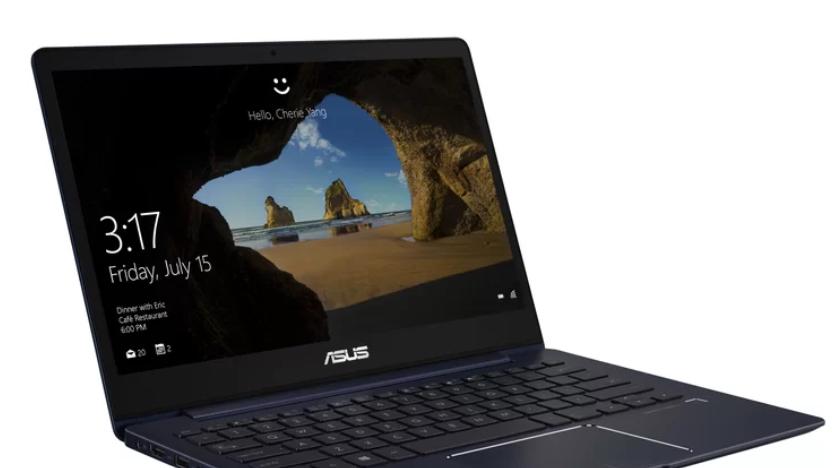
ASUS puts discrete graphics inside its ultra-thin ZenBook
ASUS showed off its ridiculously thin and light ZenBook 13 at CES earlier this year, but the model was missing a key component: a dedicated GPU. Now, though, the new ZenBook 13 UX331 offers the whole shebang at just 0.47-0.55 inches thick and weighing in at just 2.47lbs, with a discrete graphics card on board and a 13.3" FHD touchscreen display.
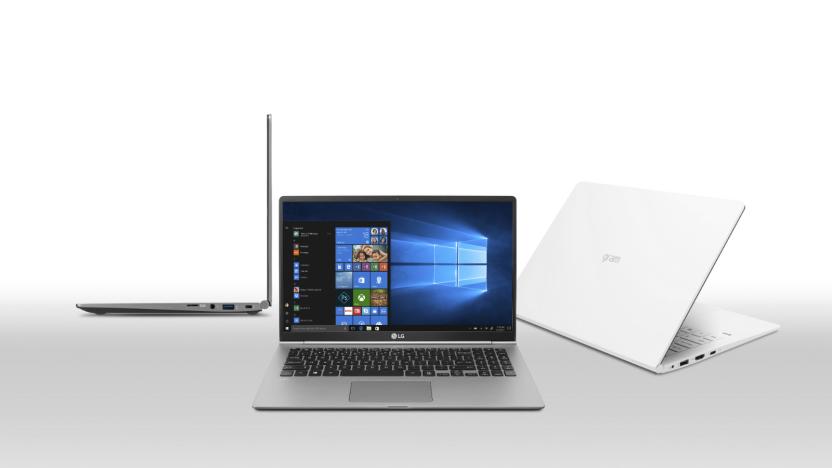
LG's refreshed Gram laptops get a quad-core processor bump
Ahead of CES, laptop makers are hurriedly unveiling the hardware they'll be showing off at the trade show. Yesterday we got the lowdown on Samsung's Surface-challenging Notebook 9 range, and now it's fellow Korean titan LG's turn to talk up its 2018 Gram line-up. As always, the company is emphasizing the portability of the lightweight ultrabooks, which hopefully won't come at the expense of a decent display this time round. The new batch includes a 13.3 inch model weighing in at 2.1 pounds, a 14 inch variant at 2.2 pounds, and a 15.6 version coming in at 2.4 pounds.
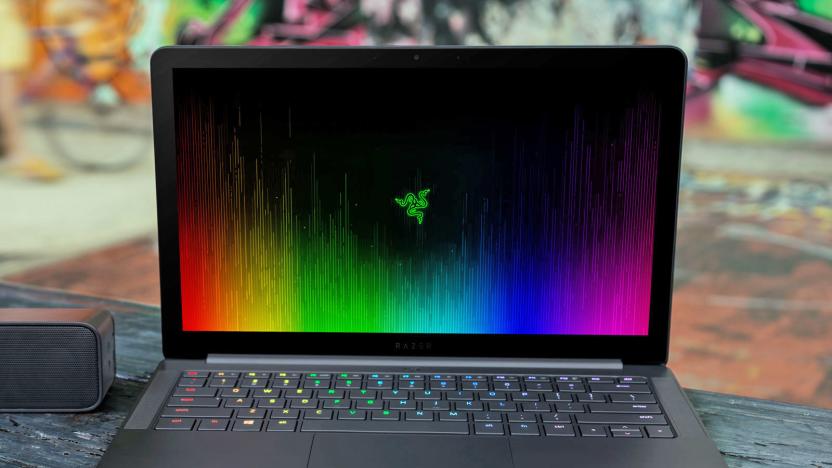
Razer's Blade Stealth laptop now packs a quad-core processor
Like the thought of Razer's Blade Stealth ultraportable, but wish it had a bit more oomph for multitasking? You're getting your wish. Razer has released a version of its 13-inch ultraportable with a quad-core 8th-generation Core i7 processor (namely, the 1.8GHz i7-8550U) inside rather than the usual 7th-gen dual-core chip. This doesn't magically turn it into a gaming machine -- you'll still need a Core enclosure for that -- but it could make all the difference when editing a video or juggling numerous apps. The CPU update also gives you an extra hour of estimated battery life (10 hours total), so you're more likely to make it through a long day.
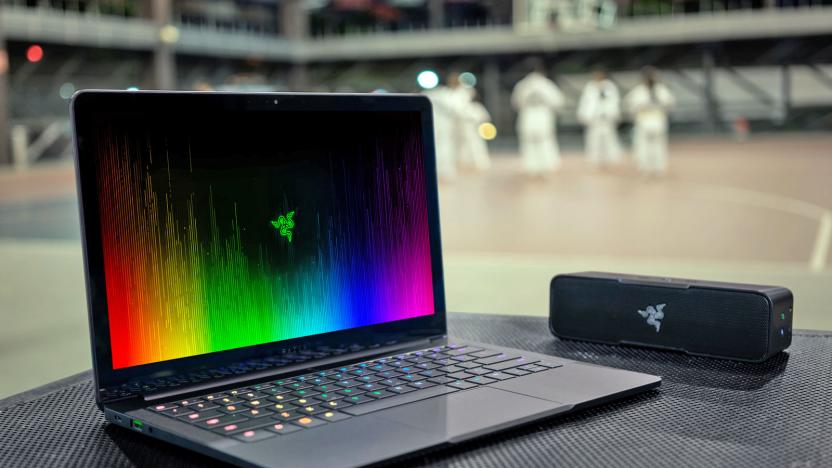
Razer's Blade Stealth packs a larger display into a familiar frame
While the Razer Blade Stealth is a solid laptop, that 12.5-inch display is rather confining -- especially when you know that there are other small laptops with larger displays. Razer is setting things right though. It's introducing a new version of the Stealth that stuffs a 13.3-inch, 3,200 x 1,800 touchscreen into a similar body. The system is slightly heavier (2.93 pounds versus 2.84), but you're still getting that half-inch thickness and claimed nine hours of battery life. The most conspicuous change is the US option for a gunmetal gray color (shown below) with a much subtler logo on the lid. In other words, you won't have to explain Razer's audacious green iconography at your next business meeting.

NVIDIA 'Max-Q' gaming laptops are Ultrabooks with GTX 1080 power
Based on NVIDIA's 2017 Computex announcements, PC gamers won't have to choose between bulky gaming laptops and desktop-level processing power for much longer. A new design called "Max-Q" is arriving in laptops that it claims are both three times thinner and three times more powerful than their predecessors. Think: 18mm thick, 5 pounds and with the power of NVIDIA's GTX 1080 inside. Plus, there's "WhisperMode," which can pace the game's frame rate to keep the laptop cool and quiet during a plugged-in gaming session.

Razer's Blade Stealth gaming ultraportable is all work and no play
At some point, every laptop-owning PC gamer asks the question, "Can I hook a desktop graphics card up to my notebook?" Until recently, the answer was no, but times are changing. In the past year Alienware, MSI and ASUS have all announced laptops with external GPU accessories, promising a workhorse on the go and a gaming behemoth at home. Razer's take on this trend took CES by storm, running away from the electronics show with Best of CES awards for both People's Choice and Best PC. And why not? The Razer Blade Stealth is sleek with impressive specs and has a strong pedigree. Still, there's a problem: This ultraportable laptop ships without the GPU dock it needs to actually play games. Whoops.

Razer's gaming Ultrabook lets you bring your own video card
If you're a gamer, you don't have it easy when buying laptops: You may want a sleek, lightweight Ultrabook when you're traveling, but you also want the big, powerful desktop replacement when you're home. What to do? Razer thinks you can have both. It's launching the Blade Stealth, a 12.5-inch ultraportable with some proper gaming cred. Its centerpiece is an optional Thunderbolt 3–powered dock, the Core (below), which lets you use most any modern desktop graphics card when integrated video won't cut it—if you just have to play Battlefront at max detail with a GeForce GTX 980 Ti, you can. It has Ethernet and four USB 3.0 ports, too, so you only need to plug in one cable to get all your usual peripherals.

LG's lightweight Gram laptops arrive in the US
LG's laptops are a common sight around the world, but you wouldn't know it in the US when the company hasn't officially brought its portables to the country. Well, that's about to change: the Korean tech giant has announced that it will sell 13- and 14-inch versions of its ultralight Gram laptops in the US through both Amazon and Microsoft Stores. They're still running 5th-generation Core processors, but they're otherwise no slouches -- they earn their name through an extremely light 980g (2.16lbs) body that makes many smaller laptops seem portly by comparison. You'll also get a respectable 1080p display and perks like HDMI video output and a microSD card slot.

VAIO resurrects its flagship Z series with two new hybrid laptops
Now that the independent company's got rid of those pesky excess components, it's time for VAIO to make something new. And it's not a smartphone. Yet. The PC maker has announced two new PCs here in Tokyo: the VAIO Z and VAIO Z Canvas. The latter is actually eventual final version of the prototype tablet that did the rounds last year -- but we'll get to that. First, inside the flagship 13.3-inch VAIO Z which goes up for preorder in Japan later today, you'll find a second -generation high-speed SSD and an unspecified fifth-generation Core i7 processor, all bound up in aluminum-carbon shell. However, bare specs aside, the company reckons its a lot of the little details that matter, and we'll get to those right after the break.

Dell's XPS 13 is easy to fix despite its size
Give Dell's XPS 13 a cursory glance and you might think that it would be a nightmare to fix. You'd surely have to get a specialist to look at something so densely packed, wouldn't you? Not so fast. The repair-it-yourself advocates at iFixit have torn down the new XPS, and it turns out that this compact Ultrabook is surprisingly easy to maintain if you're willing to put in a little elbow grease. About the only showstopper (as on many super-thin laptops) is the soldered-on RAM -- virtually every other part is easy to replace, and Dell helps you out by posting service manuals and labeling connectors. Even the signature near-borderless display isn't as hard to take apart as you'd imagine. Whether or not you like the XPS 13 when it's fully assembled, this teardown shows that ultraportables can still be DIY-friendly.

The next MacBook Air is reportedly so small it needs a new USB port
Hey, Dell: you might not be the only one in town with an impossibly small laptop this year. Tipsters for 9to5Mac claim that the long-rumored 12-inch MacBook Air is not only real, but uses a "radically new" body that's much thinner and narrower than the already tiny 11-inch system you see today, despite the larger screen. Supposedly, it's so compact that Apple is ditching most of the usual expansion -- you'd have just the headphone jack and a next-generation USB Type-C port that would take care of everything else. While that's feasible given that Type-C can handle everything from power to displays, you'd have to rely on an external hub for virtually every wired peripheral you can imagine (à la the original MacBook Air). And where would you plug devices in when you're charging, unless there's a special power adapter in the works? Whether or not Apple goes that route, you may not see this miniscule machine until "mid-2015." In other words, don't hold off on buying the existing Air unless you can afford to wait.

This is Toshiba's answer to the Surface Pro 3
Until now, if you wanted a tablet powerful enough to double as a laptop, there was really only one acceptable option: the Surface Pro 3. Sure, there were other such devices out there, but the SP3 was uniquely thin and light -- kind of a crucial detail for a device that's supposed to work equally well in notebook and tablet modes. But times, they are a-changin', and other companies are starting to catch up. Take Toshiba, for instance. The PC maker just revealed the Portege Z20t, a similarly sized laptop/tablet hybrid with a 12.5-inch screen, but an even lighter design. All told, it comes in at just 0.35 inch thick and 1.6 pounds for the tablet piece, versus 1.76 pounds for the 12-inch SP3. Basically, then, it has the same size and thickness as Microsoft's tablet, except it should be even easier to hold.
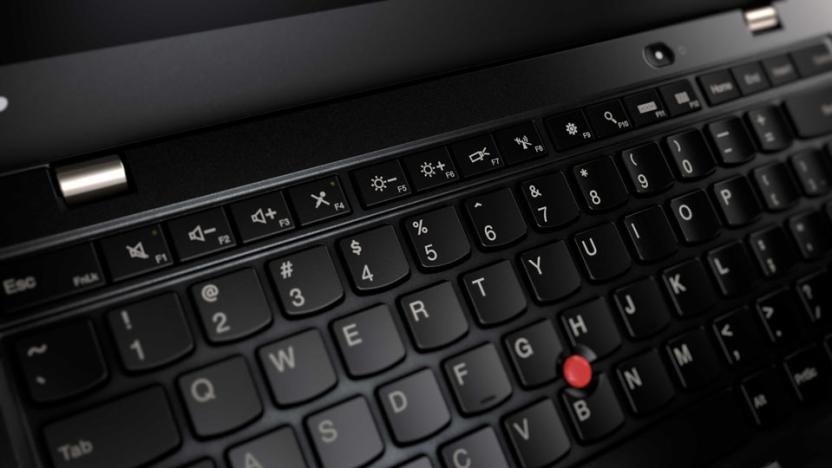
Lenovo's latest business Ultrabook does away with last year's unpopular design
You haven't known a fanboy until you've met a ThinkPad fan. The brand's loyal following (many of whom started as IBM users) can be very resistant to change. How resistant? Let's put it this way: Anytime the brand's current owner Lenovo so much as redesigns the touchpad, it does so at its own peril. That being said, Lenovo may have gone too far with last year's X1 Carbon. With the 2014 edition of its flagship business Ultrabook, Lenovo ripped out the physical Function buttons, leaving users with an "adaptive" panel whose touch-sensitive buttons changed depending on the task at hand. We weren't fond of it, and apparently real-world users weren't either: The company just unveiled the 2015 edition, and it brings back the physical function keys you all seemed to miss so much. Additionally, Lenovo undid some of the changes it had made to the touchpad. Whereas the last-gen model had a clickpad with zero buttons, this year's model returns the two right and left clickers that used to sit at the top of the pad -- the ones meant to be used with the signature red pointing stick.
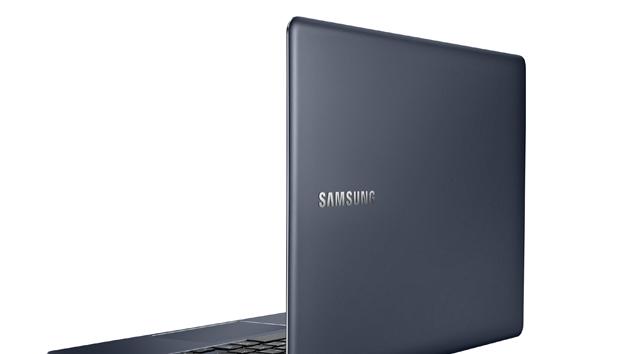
Samsung announces a curved-screen all-in-one and its thinnest laptop yet
We hope you like super skinny laptops, because you're going to be seeing a hell of a lot more of them in 2015. Samsung just took the veil off its new ATIV Book 9 Ultrabook, which comes in at just 0.45 inch thick and 2.09 pounds. That's insanely compact for a 12.2-inch machine and indeed, it's the thinnest and lightest notebook Samsung has released yet. (Given Sammy's history with razor-thin laptops, that's saying a lot.) Like so many other slim machines that have come out lately, the Book 9 uses one of Intel's new Core M processors, which were designed specifically to allow for skinnier designs.

Lenovo Yoga 3 Pro review: slim and sexy comes with some trade-offs
I haven't reviewed an Ultrabook in months. It's not because I've grown lazy; it's because there just haven't been many new models to test. Nearly every laptop that crosses Engadget's reviews desk these days is a gaming notebook, a Chromebook or maybe one of those super-cheap netbook things. So here I am, dusting off my Ultrabook-testing skills with the Lenovo Yoga 3 Pro, the company's latest flagship laptop. Like every Yoga that's come before it, this new model has a 360-degree hinge that allows it to fold back into tablet mode. It also keeps that stunning 3,200 x 1,800 touchscreen. But that's not what's interesting to me. No, I'm curious about this because it's the first notebook I'm testing with a new Intel Core M chip, which allows the Yoga 3 Pro to be 17 percent thinner than its predecessor, not to mention 15 percent lighter. As a result of moving to a lower-powered chip, the battery life should be better too. Sounds like a recipe for an all-around better Ultrabook, right?

Here's why Apple doesn't have a MacBook Air with a Retina display
Another Apple event has come and gone, and there's still no MacBook Air with a Retina display. I won't blame you if you're frustrated -- now that there's a 5K iMac, the Air is Cupertino's last screen-packing computer to ship without an extreme-resolution display. For that matter, competitors haven't had qualms about releasing their own ultraportable laptops with extra-crisp visuals. So, what gives? Is Apple holding back? The company may not be offering answers, but it's most likely that the technology needed to make a Retina-equipped Air simply isn't ready for prime time. As much as Apple would like the Air to hop on the high-res bandwagon, it may have to wait until a whole bunch of pieces fall into place. Read on to see what I mean.

ASUS' slim metallic Zenbook gets a super sharp 13.3-inch screen
ASUS' Zenbook UX301 was already rather impressive with its glass-covered body and 2,560 x 1,440 touchscreen, but its record has just been broken by yet another Zenbook. Announced at IFA today, the new UX305 is a gorgeous all-aluminum Ultrabook that packs an insanely sharp 13.3-inch 3,200 x 1,800 (276 ppi) display (as used by the bulkier UX303LN), and at just 12.3mm thick, it's certainly the world's slimmest laptop to carry this class of screen resolution. The trade-off here is that this isn't a touchscreen, but the 1.2kg weight does beat the 1.35kg 13-inch MacBook Air. Much like the rest of the Zenbook series, the UX305 is also quite the looker with its diamond-cut highlights plus signature spun-metal finish in either "Obsidian Stone" or "Ceramic Alloy" color option. Little else about this laptop has been mentioned so far: All we know is that it'll pack an Intel Core M processor, 10 hours of battery life and a choice of 128GB/256GB SSDs. We'll get back to you guys when we hear more later this year.
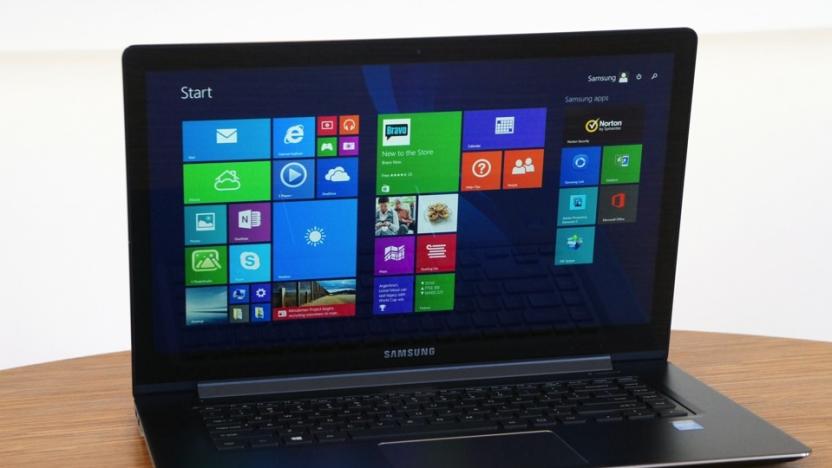
Samsung ATIV Book 9 2014 Edition review: big screen, even bigger price
So many Ultrabooks in our laptop buyer's guide: Not one with a 15-inch screen. Which is strange, because it seemed for a while that bigger-screen ultraportables were going to become a thing; HP, Sony and ASUS all tried their hand at super-light 15-inch machines. Two years later, though, Samsung is one of the only companies that's still at it. The company recently came out with the ATIV Book 9 2014 Edition, an update to the 15-inch Series 9 laptop from 2012. Like the original, it's insanely thin and light for a machine with this screen size, except now, it graduates to a full HD touchscreen, longer battery life and updated processors. Most notable of all, it features an improved audio setup with a built-in digital-to-analog converter allowing you to play back lossless, or "studio-quality" audio formats. The thing is, even for a flagship it's pretty expensive: At $1,500, it has one of the highest starting prices we've seen, and there are plenty of similarly specced machines that cost less. That raises an interesting question, then: Who should buy this?

Toshiba details 4K laptop arriving before summer
Toshiba has just dished most of the important details about its intriguing 4K Satellite P50t that we saw at CES 2014, along with some other new models. Unfortunately, it's left some info hanging -- namely the all-important prices. For the most part, the Satellite 50t model sounds pretty fine, considering the sleek 2.2kg (4.8 pound) weight. There's that exotic 282 pixel per inch 3,840 x 2,160, 15.6-inch touchscreen, driven by 2GB AMD Radeon R9 M265 graphics, for starters (1080p is optional). It's also packing an Intel Core-i7 CPU, 16GB DDR3L RAM, 4 USB 3.0 ports, an SD/SDHC slot, Bluetooth 4.0, 802.11ac WiFi and Windows 8.1. Oddly, the otherwise well-spec'd device only features a 1TB mechanical disk option, when it's clearly screaming for SSD speed -- hopefully Toshiba will rectify that prior to release. Availability is listed as sometime in Q2, but again, there's no clue about pricing. Meanwhile, Toshiba's also detailed a few other models after the break.
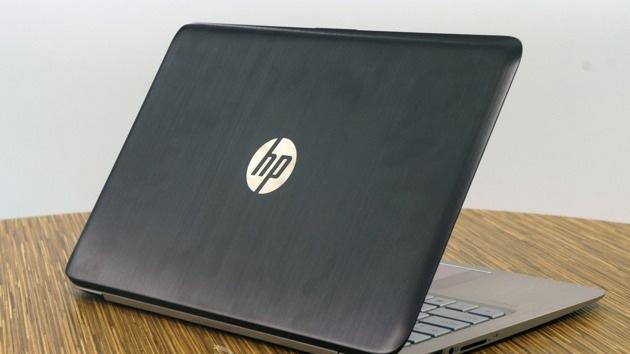
HP Spectre 13 Ultrabook review: a good deal, but with trade-offs
It's already March, dear readers, which means with the exception of this post right here, you're not going to find many laptop reviews on this site. Why? Because Intel's just three months away from launching its next-generation chips and besides, we've reviewed most of the current-gen models anyway. But not HP's. We haven't reviewed a Hewlett-Packard Ultrabook in more than a year. So here we are, picking up where we left off. The company's newest flagship, the Spectre 13, has a metal-clad body, much like the older models we've tested, except it steps up to an optional 2,560 x 1,440 display and an extra-wide touchpad designed to make all those Windows 8 gestures easier to pull off. It also starts at $1,000, making it a good deal cheaper than most of the other models we'll be name-checking throughout the review. So does that make it a good deal?








